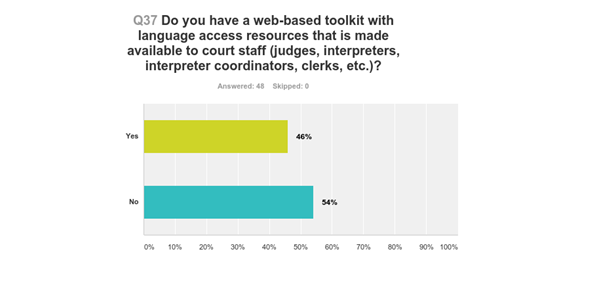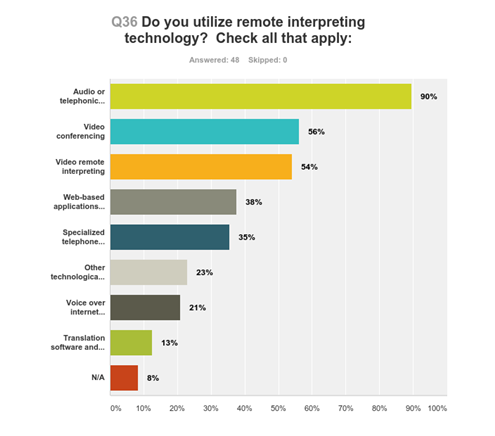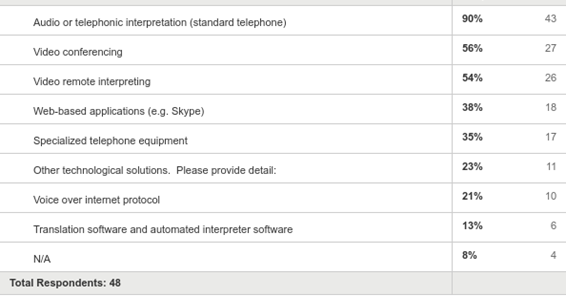Utilize Remote Interpreting Technology to fulfill LEP needs and ensure quality services.
As LEP populations continue to grow, the demand on interpreter services increasingly poses great challenges to large and small jurisdictions in both rural and urban areas. Further, the variety of languages needed is constantly fluctuating. It has become essential, in some areas, to use technology in the court to allow interpreters to be electronically present.
Currently, according to the survey, the majority of states utilize some form of remote interpreting technology. The most commonly used form is audio or telephonic interpretation, which is standard telephone. Almost 90% of the respondents use audio interpretation. Over half of the jurisdictions report that they use video conferencing and video remote interpreting. Web-based applications, such as Skype, are also commonly used. Courts frequently are using specialized telephone equipment and voice over internet protocol. Translation software and automated interpreter software are also used, but much less frequently than other options available.
A number of states specified that because they are decentralized, technology usage varies widely across the state. Local courts employ a variety of technology for video and/or audio conferencing. Also, remote ASL is becoming more frequently utilized.
In addition to the technology listed above, jurisdictions reported in the survey that they use the following technology and also provided additional detail:
- We are currently purchasing a large number of laptops for clerk's counters and commissioner stations for use with remote ASL.
- VRI for ASL interpreted events. VRI Pilot Project for spoken languages to commence in Summer (July) 2017
- Regarding translation software, the Branch owns several Trados licenses. This translation memory software expedites the translation of vital documents and ensures consistency in terminology.
- Local courts are not using remote interpreting extensively except for telephonic services.
- We are beginning a pilot which will include tele-presence including Cisco products, Skype, VoIP.
- As part of the Hawaii State Judiciary's 2020 Strategic Plan, the Judiciary continues to upgrade its facilities to meet standards of "courtrooms in the 21st century." Efforts include incorporating video remote interpreting capability in courtrooms statewide -Selected courtrooms are VCC capable. Videoconferencing used for arraignments for custody defendants at prisons (Also used for ASL interpreters in court
Web-based Toolkit Features
Less than half of the jurisdictions participating in the survey report having a web-based toolkit with language access resources. These resources are made available to court staff, including judges, interpreters, interpreter coordinators, and clerks.


Jurisdictions that answered that they do have a web-based toolkit were asked to describe the most helpful or effective features that they would recommend to other jurisdictions. Many states recommended posting online resources and materials for judges and staff, including bench cards, information cards, and court rules and guidance on providing language access. Also frequently recommended was posting online information for interpreters and potential interpreters, including interpreter resources, and certification information.
Jurisdictions recommended the following web-based toolkit features:
- Directory listing of court-certified interpreters. Policies and procedures for best practices
- A learning management system where we house bench guides, bench cards, and online tutorials.
- Statewide Registry, Language Access Policy and Interpreter Code of Ethics, judicial bench cards, and information cards for attorneys and clerks.
- The court system provides resources for interpreters, the public and attorneys on the court system's home page. We provide resources for judges and court staff on the INTRAnet.
- Language access bench card for staff and steps for providing language access services posted on Judiciary intranet for all staff.
- Online materials. Detailed rules guiding judges and interpreters regarding credentialing and language access.
- Our interpreter webpage contains our Language Access Plan, bench cards for judges, information cards for clerks and attorneys, glossaries and lists all the credentialed interpreters with their contact information along with resources for judges, interpreters, clerks, etc.
- Intranet web pages
 The step-by-step process for accessing language services.
The step-by-step process for accessing language services. - Language access website: This includes videos by one of our Supreme Court Justices on a variety of topics related to language access. The portal includes bench cards, interpreter's oath, rules, procedures and helpful tips and it also includes a cultural competency section. Language Access Basic Training: This is a self-paced downloadable interactive application to train bilingual employees to provide language access outside the courtroom. The fundamentals module is also available online.
- We purchased a number of training slots for New Mexico's LABT (Language Access Basic Training) program 2 years ago, and required all local language access coordinators, plus 1 additional staffer (ideally one with frequent contact with the LEP public) from each local court, to take the program. Staffers found the scenario feature in the program to be especially helpful.
- Specific information on individual topics is most relevant for users.
- Bench cards, Archived WebEx trainings for judges and court staff, best practices guide.
- Language Access Toolkit
- Judicial Intra-net; Court Interpreter Online statewide court interpreter directory, accessible to local language access coordinators.
- A language services section infonet page where everything language access is available to staff.
- Language Access Information for Judges & Court Personnel
- Program can update Registry and other lists and forms.









